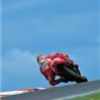The first time I used this Starlane GPS-3 laptimer, I shook my head in dismay.
Not because it was hard to use - far from it - but because it made me realise how I'd been going about my racing - qualifying in particular - the wrong way.
You see, before I used a lap timer, I went out in qualifying and rode around like I had a wasp in my leathers, hoping I'd set a good time. With no team to speak of and no boards being held out on the pit wall I kept going 'til the chequered flag, hoping, I s'pose, I'd done what I needed to do.
The result was usually a fairly average time and a slightly knackered rear tyre.
Since fitting the Starlane GPS-3, things have changed.
It's easy to rig up - you just wire it to the battery and use the sticky velcro pads to attach it to your bike (I put mine on my dash but you could use your headstock, tank etc.)
Once on, you cycle through the menu, tell it you're at a track and it prepares itself for the next step. All you need to do now is set your sectors and the finish line. You do this by pressing the 'ENTER' button on the dash.
So on my first lap out during Free Practice, I set my sectors, one, two, three, then as I cross the finish line I press enter for the fourth time. That's it, the Starlane now knows the lap and where to take your sector times.
Now comes the good bit: the little light you can see at the top of the dash flashes at you when you've posted a best sector time. I don't need to know what time I'm doing, just that I'm going faster than I have before.
If I don't see the light flash on a couple of sectors, I know I'm not on the pace and I can do something about it; either come into the pits and catch a breath, or bin the lap and start again. When you cross the finish line, the unit flashes up your time and if you're on a circuit with a decent straight, you can have a quick glance to see where you're at.
Now my qualifying routine consists of heading out with a time in mind, concentrating on stringing together one flying lap - with one eye on the flashing LED - and when I've got that lap, coming in if I think I don't have anything left to give.
The result is I spend far less time out on track trying to carve out a time but the time I do spend out on track, I know what I'm doing. In the 848 Challenge this counts as we're limited to the number of tyres we can run so preserving tyres is a useful extra. It's pretty annoying when your 3rd lap was your best but you spent another 5 going 'round in circles, wasting tyres, fuel and energy and not going any faster.
When you get back to base, you can easily recall your lap times and it'll also tell you your theoretical best, based on your best sector from every lap.
What amazes me if how accurate it is when put up against the transponders we have to run as part of the 848 Challenge. When I crossed the line at Assen, the Starlane told me I'd done a 1:49.70 and when I picked up the results sheet, which uses times from the circuit's transponders that are mounted on my bike and read off the start/finish line, they got me at 1:49.709.
That's more accurate than even the keenest girlfriend armed with an iPhone stopwatch and believe me, you see a lot of those on the pit wall at trackdays and race meetings.
You can plug the Starlane into your laptop and download all sorts of data and it can also be used as a data acquisition hub for external sensors ( throttle, gear, RPM) so if you're a real geek, you can mess around until your heart's content.
I genuinely wish I'd started using a laptimer sooner, but I'm glad I've picked the Starlane GPS-3; it's easy to fit, easy to use and it's perfectly accurate. No more riding around in the dark.
If you're a racer or a trackday junkie, it's well worth a look.
The Starlane GPS-3 has been superceeded by the GPS-3X whichis essentially the same unit with different - easier to use - buttons.
Cost: £359.99
Contact: www.sportsbikeshop.co.uk
��

